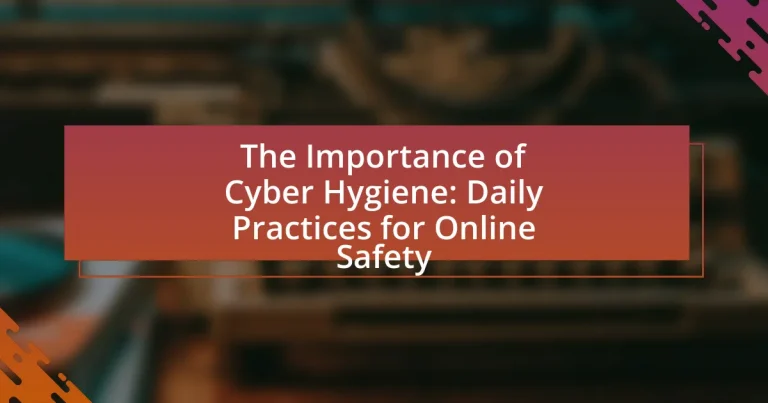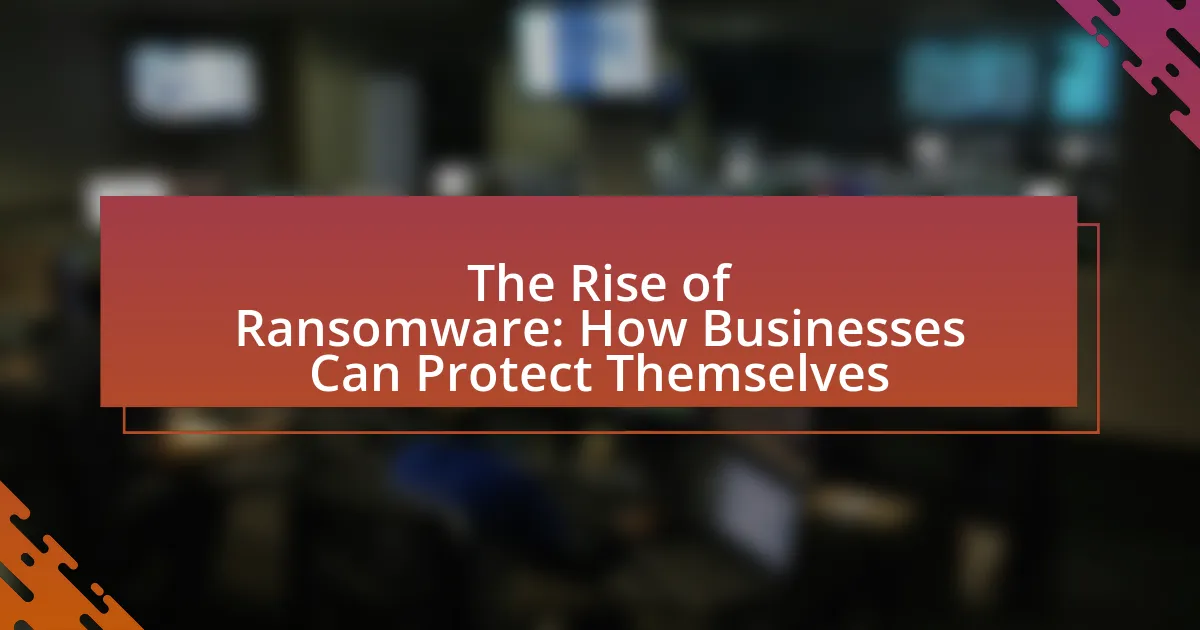Cyber hygiene encompasses the practices and steps individuals and organizations take to secure their digital devices and online presence, including regular software updates, strong password usage, and awareness of phishing attempts. This article emphasizes the critical importance of cyber hygiene for online safety, detailing key principles such as maintaining strong passwords and software updates, while distinguishing it from broader cybersecurity practices. It addresses common misconceptions, the consequences of poor cyber hygiene, and offers practical tips for improvement, highlighting the necessity of ongoing education and self-assessment in enhancing personal and organizational security against cyber threats.
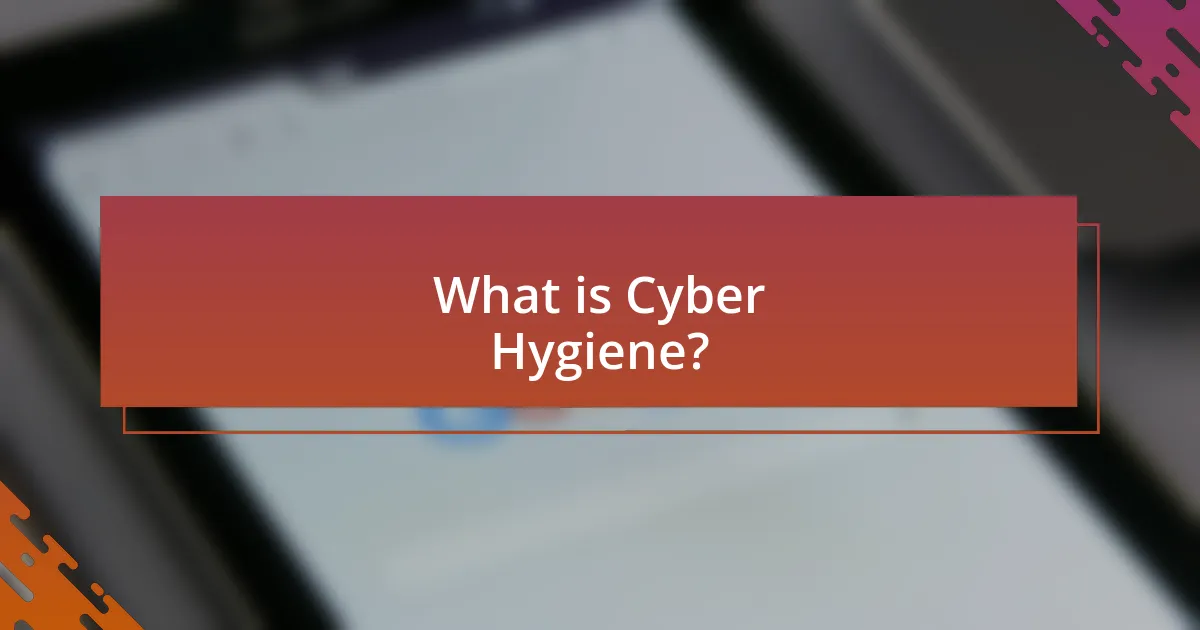
What is Cyber Hygiene?
Cyber hygiene refers to the practices and steps that individuals and organizations take to maintain the health and security of their digital devices and online presence. These practices include regularly updating software, using strong and unique passwords, enabling two-factor authentication, and being cautious of phishing attempts. According to the Cybersecurity & Infrastructure Security Agency (CISA), maintaining good cyber hygiene significantly reduces the risk of cyber threats and data breaches, thereby enhancing overall online safety.
Why is Cyber Hygiene essential for online safety?
Cyber hygiene is essential for online safety because it involves maintaining practices that protect personal and organizational data from cyber threats. Regularly updating software, using strong passwords, and being aware of phishing attempts significantly reduce the risk of data breaches and cyberattacks. According to a report by Cybersecurity Ventures, cybercrime is projected to cost the world $10.5 trillion annually by 2025, highlighting the critical need for effective cyber hygiene practices to mitigate these risks.
What are the key principles of Cyber Hygiene?
The key principles of Cyber Hygiene include maintaining strong passwords, regularly updating software, using antivirus protection, and being cautious with email and online interactions. Strong passwords, which should be complex and unique for each account, help prevent unauthorized access. Regular software updates patch vulnerabilities that could be exploited by cybercriminals. Antivirus protection actively scans for and removes malware, enhancing overall security. Additionally, exercising caution with emails and online interactions, such as avoiding suspicious links and attachments, reduces the risk of phishing attacks and other cyber threats. These principles collectively contribute to a robust defense against cyber threats, as supported by cybersecurity frameworks and best practices established by organizations like the National Institute of Standards and Technology (NIST).
How does Cyber Hygiene differ from general cybersecurity practices?
Cyber Hygiene focuses on the routine practices and behaviors that individuals and organizations adopt to maintain their online safety, while general cybersecurity practices encompass broader strategies and technologies designed to protect systems and networks from threats. Cyber Hygiene emphasizes daily actions such as regularly updating software, using strong passwords, and being cautious with email links, which are essential for personal security. In contrast, general cybersecurity practices may include implementing firewalls, intrusion detection systems, and comprehensive security policies that protect the entire infrastructure. The distinction lies in Cyber Hygiene being more about individual responsibility and proactive habits, whereas general cybersecurity practices involve organizational measures and technical solutions to safeguard against cyber threats.
What are the common misconceptions about Cyber Hygiene?
Common misconceptions about Cyber Hygiene include the belief that it is solely the responsibility of IT departments, that strong passwords alone ensure security, and that cyber hygiene practices are only necessary for large organizations. Many individuals assume that only technical experts need to implement cyber hygiene, neglecting their own role in maintaining security. Additionally, while strong passwords are crucial, they must be complemented by other practices such as regular software updates and awareness of phishing threats. Furthermore, small businesses and individual users are equally vulnerable to cyber threats, making cyber hygiene essential for everyone, not just large entities. These misconceptions can lead to inadequate security measures and increased risk of cyber incidents.
Why do people underestimate the importance of Cyber Hygiene?
People underestimate the importance of Cyber Hygiene primarily due to a lack of awareness about the potential risks associated with poor online practices. Many individuals believe that cyber threats are exaggerated or that they are not personally at risk, leading to complacency. Research from the Cybersecurity & Infrastructure Security Agency indicates that 90% of cyber incidents are caused by human error, highlighting the critical role of individual behavior in maintaining security. Additionally, the complexity of cybersecurity concepts can overwhelm users, causing them to dismiss the need for regular hygiene practices. This combination of ignorance and misunderstanding contributes significantly to the underestimation of Cyber Hygiene’s importance.
How can misinformation about Cyber Hygiene be harmful?
Misinformation about Cyber Hygiene can be harmful as it leads individuals to adopt ineffective or dangerous online practices. For instance, believing that antivirus software alone is sufficient for protection can result in neglecting essential practices like regular software updates and secure password management. According to a study by the Cybersecurity & Infrastructure Security Agency, 90% of successful cyber attacks are due to human error, often stemming from misinformation about safe online behaviors. This highlights that incorrect beliefs about Cyber Hygiene can significantly increase vulnerability to cyber threats, ultimately compromising personal and organizational security.
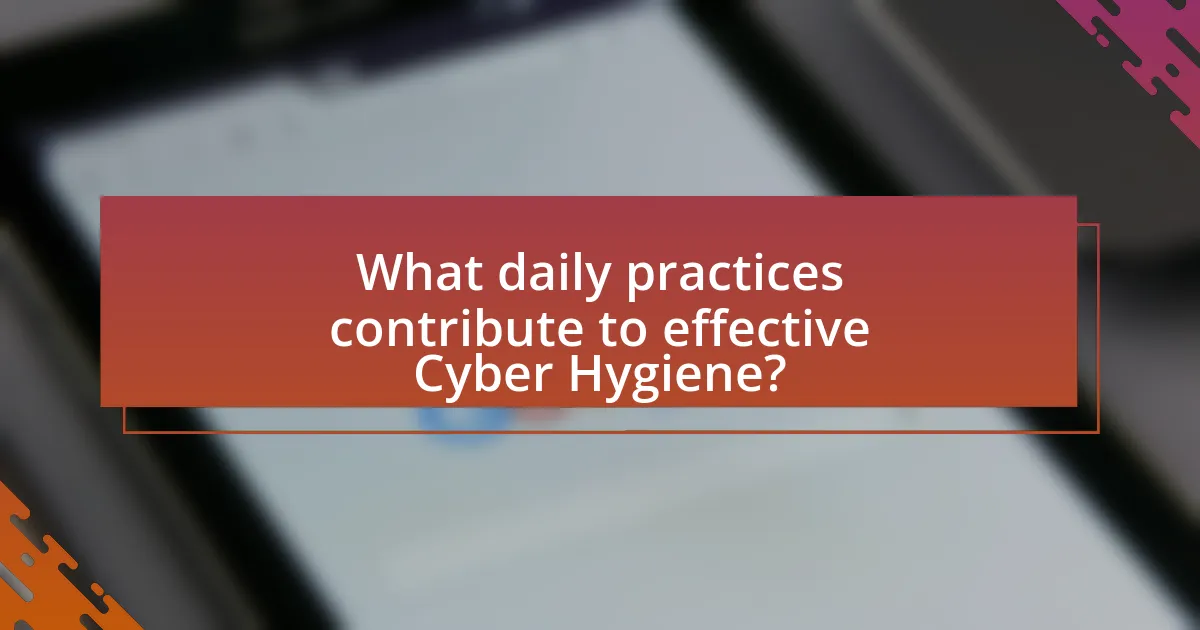
What daily practices contribute to effective Cyber Hygiene?
Daily practices that contribute to effective Cyber Hygiene include regularly updating software, using strong and unique passwords, enabling two-factor authentication, and being cautious with email attachments and links. Regular software updates patch vulnerabilities, reducing the risk of exploitation; strong passwords prevent unauthorized access, and two-factor authentication adds an extra layer of security. Additionally, being cautious with emails helps avoid phishing attacks, which are a common method for cybercriminals to gain access to sensitive information. According to the Cybersecurity & Infrastructure Security Agency (CISA), implementing these practices significantly lowers the risk of cyber threats and enhances overall online safety.
How can strong passwords enhance Cyber Hygiene?
Strong passwords enhance cyber hygiene by significantly reducing the risk of unauthorized access to sensitive information. When passwords are complex, incorporating a mix of letters, numbers, and symbols, they become harder for attackers to guess or crack using brute force methods. According to a study by the National Institute of Standards and Technology (NIST), weak passwords are responsible for 81% of data breaches, highlighting the critical role that strong passwords play in protecting personal and organizational data. By implementing strong passwords, individuals and organizations can create a foundational layer of security that supports overall cyber hygiene practices, thereby minimizing vulnerabilities and enhancing online safety.
What are the characteristics of a strong password?
A strong password is characterized by its length, complexity, and unpredictability. Specifically, it should be at least 12 characters long, incorporating a mix of uppercase letters, lowercase letters, numbers, and special symbols. This combination makes it significantly harder for attackers to guess or crack the password through brute force methods. Research indicates that passwords with these characteristics can take years to crack using current technology, whereas simpler passwords can be compromised in seconds. Therefore, adhering to these guidelines enhances security and protects sensitive information from unauthorized access.
How often should passwords be changed for optimal security?
Passwords should be changed every three to six months for optimal security. This recommendation is supported by cybersecurity experts who emphasize that regular updates reduce the risk of unauthorized access, especially in light of frequent data breaches. The National Institute of Standards and Technology (NIST) advises that changing passwords too frequently can lead to weaker passwords, but a balance of periodic updates is essential to maintain security.
What role does software updates play in Cyber Hygiene?
Software updates are crucial for maintaining cyber hygiene as they address security vulnerabilities, enhance system performance, and introduce new features. Regularly applying updates mitigates the risk of cyberattacks, as outdated software is often targeted by malicious actors exploiting known weaknesses. For instance, a report by the Cybersecurity and Infrastructure Security Agency (CISA) indicates that 85% of successful cyberattacks exploit known vulnerabilities, which could be patched through timely software updates. Thus, consistent software updates are essential for safeguarding personal and organizational data against evolving cyber threats.
Why is it important to keep software up to date?
Keeping software up to date is crucial for maintaining security and functionality. Regular updates often include patches that fix vulnerabilities, reducing the risk of cyberattacks; for instance, in 2020, 80% of breaches involved unpatched software, according to the Verizon Data Breach Investigations Report. Additionally, updates can enhance performance and introduce new features, ensuring that users benefit from the latest advancements. Therefore, consistently updating software is essential for protecting systems and optimizing user experience.
How can outdated software expose users to risks?
Outdated software exposes users to risks primarily by leaving vulnerabilities unpatched, which can be exploited by cybercriminals. When software is not updated, it lacks the latest security features and fixes that protect against known threats. For instance, a report by the Cybersecurity and Infrastructure Security Agency (CISA) indicates that 60% of breaches involve unpatched vulnerabilities. Additionally, outdated software may not support newer security protocols, making it easier for attackers to gain unauthorized access to systems and sensitive data.
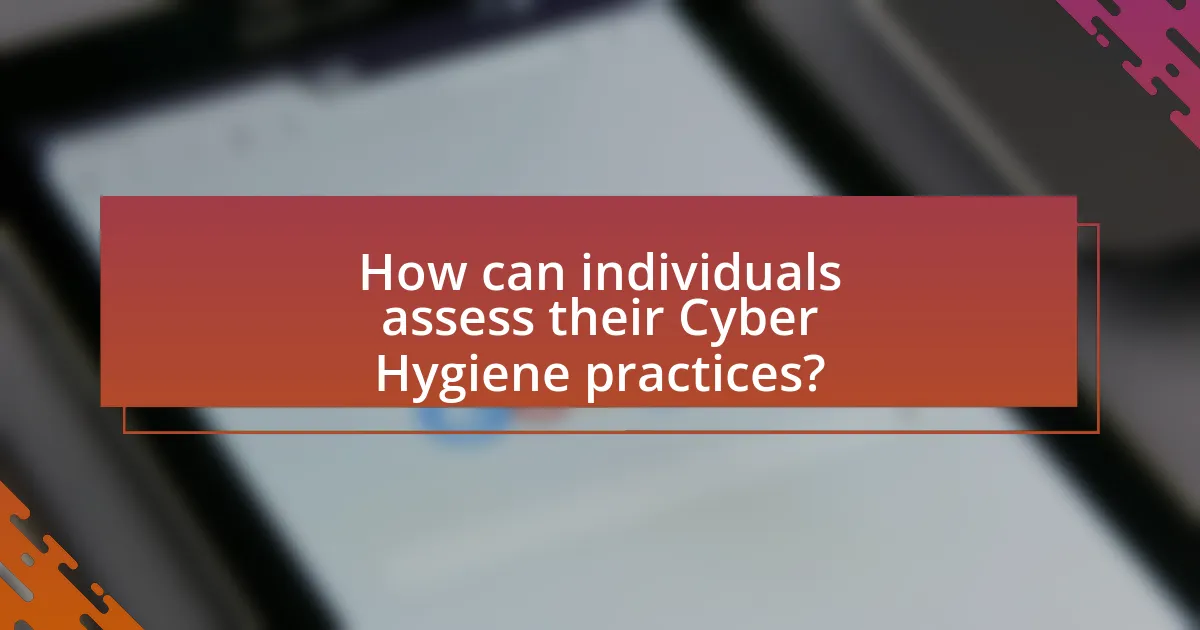
How can individuals assess their Cyber Hygiene practices?
Individuals can assess their Cyber Hygiene practices by conducting regular evaluations of their online security measures and behaviors. This assessment can include reviewing password strength, ensuring software updates are applied, and checking privacy settings on social media accounts. According to a 2021 study by the Cybersecurity & Infrastructure Security Agency, 85% of data breaches involve human error, highlighting the importance of self-assessment in identifying vulnerabilities. Additionally, utilizing tools such as security checklists or online assessments can provide a structured approach to evaluating one’s cyber hygiene.
What tools are available for evaluating Cyber Hygiene?
Tools available for evaluating Cyber Hygiene include security assessment frameworks, vulnerability scanners, and compliance checklists. Security assessment frameworks like the NIST Cybersecurity Framework provide guidelines for evaluating an organization’s cybersecurity posture. Vulnerability scanners such as Nessus and Qualys automate the detection of security weaknesses in systems and applications. Compliance checklists, often based on standards like ISO 27001, help organizations ensure they meet specific cybersecurity requirements. These tools collectively enable organizations to assess and improve their cyber hygiene effectively.
How do these tools help in identifying vulnerabilities?
These tools assist in identifying vulnerabilities by systematically scanning systems for weaknesses and misconfigurations. They utilize various techniques such as network mapping, port scanning, and vulnerability databases to detect potential security flaws. For instance, tools like Nessus and Qualys can identify outdated software versions, missing patches, and insecure configurations, which are common entry points for cyber attacks. According to a report by the Ponemon Institute, organizations that regularly use vulnerability scanning tools reduce their risk of data breaches by 50%. This demonstrates the effectiveness of these tools in enhancing cybersecurity by proactively identifying and addressing vulnerabilities.
What metrics should be considered when assessing Cyber Hygiene?
When assessing Cyber Hygiene, key metrics to consider include the frequency of software updates, the strength of password policies, the rate of phishing attack simulations, and the number of security incidents reported. Regular software updates are crucial as they patch vulnerabilities; for instance, a study by the Ponemon Institute found that 60% of data breaches are linked to unpatched software. Strong password policies, such as requiring complex passwords and regular changes, significantly reduce unauthorized access risks. The effectiveness of phishing simulations can be measured by the percentage of employees who fall for simulated attacks, which helps gauge awareness and training effectiveness. Lastly, tracking the number of reported security incidents provides insight into the overall security posture and areas needing improvement.
What are the consequences of poor Cyber Hygiene?
Poor cyber hygiene can lead to severe consequences, including data breaches, identity theft, and financial loss. Organizations and individuals who neglect basic cybersecurity practices expose themselves to increased risks of malware infections, phishing attacks, and unauthorized access to sensitive information. According to a report by IBM, the average cost of a data breach in 2021 was $4.24 million, highlighting the financial impact of inadequate cyber hygiene. Additionally, poor practices can result in reputational damage, loss of customer trust, and legal liabilities, as companies may face regulatory penalties for failing to protect personal data.
How can poor Cyber Hygiene lead to data breaches?
Poor cyber hygiene can lead to data breaches by creating vulnerabilities that cybercriminals exploit. When individuals or organizations neglect basic security practices, such as using weak passwords, failing to update software, or not implementing multi-factor authentication, they increase the risk of unauthorized access to sensitive information. For instance, a study by the Ponemon Institute found that 80% of data breaches are caused by weak or stolen passwords, highlighting the critical role of password management in maintaining security. Additionally, outdated software can contain known vulnerabilities that hackers can easily exploit, as evidenced by the 2017 Equifax breach, which was largely attributed to unpatched software flaws. Thus, poor cyber hygiene directly correlates with an increased likelihood of data breaches.
What impact does poor Cyber Hygiene have on personal and professional life?
Poor cyber hygiene significantly increases the risk of data breaches and cyberattacks, adversely affecting both personal and professional life. Individuals may experience identity theft, financial loss, and emotional distress due to compromised personal information. In a professional context, organizations face reputational damage, legal liabilities, and financial penalties resulting from data breaches. According to a report by IBM, the average cost of a data breach in 2023 was $4.45 million, highlighting the financial implications for businesses. Furthermore, poor cyber hygiene can lead to loss of sensitive intellectual property, which can hinder competitive advantage and innovation. Thus, maintaining good cyber hygiene is essential for safeguarding personal well-being and ensuring organizational integrity.
What are some practical tips for improving Cyber Hygiene?
To improve Cyber Hygiene, regularly update software and operating systems to protect against vulnerabilities. Keeping software current ensures that security patches are applied, reducing the risk of exploitation; for instance, a report by the Cybersecurity & Infrastructure Security Agency (CISA) indicates that 85% of successful cyber attacks exploit known vulnerabilities that could be mitigated by timely updates. Additionally, using strong, unique passwords for different accounts enhances security; according to a study by the National Institute of Standards and Technology (NIST), weak passwords are a leading cause of data breaches. Implementing two-factor authentication (2FA) adds an extra layer of protection, making unauthorized access significantly more difficult. Regularly backing up data is also crucial, as it ensures recovery in case of ransomware attacks, which affected over 400 million individuals in 2020 alone, according to cybersecurity statistics. Lastly, educating oneself and others about phishing scams and suspicious online behavior can prevent falling victim to social engineering attacks, which account for 90% of data breaches.
How can users create a daily Cyber Hygiene checklist?
Users can create a daily Cyber Hygiene checklist by identifying essential security practices and organizing them into a structured format. This checklist should include tasks such as updating software and applications, using strong and unique passwords, enabling two-factor authentication, regularly backing up data, and monitoring account activity for suspicious behavior. Research indicates that consistent application of these practices significantly reduces the risk of cyber threats, as highlighted in the 2021 Cybersecurity Awareness Report by the Cybersecurity & Infrastructure Security Agency, which states that 85% of successful cyber attacks exploit human error. By following this structured approach, users can enhance their online safety effectively.
What resources are available for ongoing Cyber Hygiene education?
Ongoing Cyber Hygiene education resources include online courses, webinars, and government initiatives. Organizations such as the Cybersecurity and Infrastructure Security Agency (CISA) offer free resources and training materials aimed at improving cybersecurity awareness. Additionally, platforms like Coursera and edX provide courses on cybersecurity fundamentals, while the National Cyber Security Centre (NCSC) offers guidance and best practices for individuals and businesses. These resources are validated by their widespread use in educational institutions and professional training programs, ensuring that they are effective in enhancing cyber hygiene practices.
